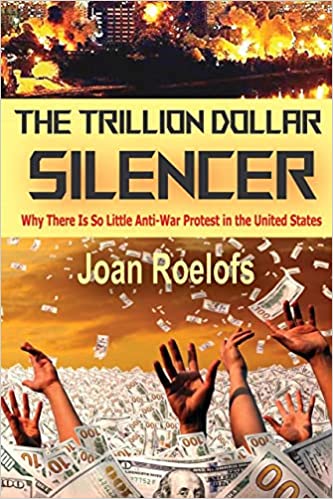I
n The Trillion Dollar Silencer, Joan Roelofs asks the intriguing, yet mind-baffling question of “Why is there so little anti-war protest in the United States?”, especially when the repercussions of war’s damages reach people, nations, and the environment—whilst being incredibly draining on the society at large.
How has militarism been so accepted, not only by public opinion but also by groups that have traditionally spoken up? Why is taxpayer money repetitively poured into the military industrial complex? How has the outrage against the destruction of war been muzzled? Are civil society sectors complicit? How has the arms sector consolidated and kept its place in the American political system? The answer lies in propaganda, money, and the political economy of war-making.
Roelofs opens with Eisenhower’s Farewell Address to the Nation in 1961 where he mentions the integration of the arms industry and the military establishment into the American experience with a total influence on all aspects of the latter. His speech warned of the implications of this development and the price there is to pay if such power by the military-industrial complex is unchecked.
The Trillion Dollar Silencer connects the complicated web of organizations, industries, partnerships, and agencies that silently evolved to become a system of governance in which the military-industrial complex plays an immensely powerful role. Roelofs highlights, in a nod to Eisenhower’s speech, that the democratic systems of the nation are caught up in these networks and overpowered. By shining a light on the extent of the patronage relations and networks between such organizations and the military-industrial complex, Roelofs intends to spread recognition on the issue in order to confront it more effectively.
The use of force is considered immoral by the public and illegal by international law. Yet, the public, the press, and politicians are undisturbed by the aggressive interventions of the United States. Why so? Roelofs first brings three factors to attention: propaganda, fear of reprisal, and distraction.
Propaganda plays a large role in manufacturing the setting of silence. Many differing areas, such as education, politics, civil society organizations, and the media, which are expected to uphold and inform the views of the public, become a tool of deflection and indoctrination. The fear of reprisal arises from the embeddedness of military and weapons manufacturing via money, engagement, and prestige. Those who may want to take a stand have to sacrifice much for too little. Meanwhile distractions work in parallel with the silence and deflections; distractions are everywhere, yet they may be carefully fueled by the aforementioned organizations to foster tranquility.
Roelofs also mentions hidden and visible interests in the formation of this web. Some interests may be well intended; however, they do not ultimately take away from the bigger damage which the system inflicts.
The loudest silencer of all is money. Roelofs explains how the military-industrial complex keeps the economy afloat, although, in practice, the distribution is unjust. The military sector is a growing, highly incentivized, recession-proof sector with few drawbacks to costs from the economic perspective. Furthermore, the military economy yields a high return on investments.
Whatever happened to the pacifists? The Trillion Dollar Silencer brings to attention how militarized the U.S. really is. It is highly devoted and shaped by war. But more importantly, the boundaries between military and civilian are blurred in the many ways Roelofs has mentioned. Which in turn, further fuels militarization without public notice as the outlines of what militarization is remains uncertain. On a global scale, U.S. dominance has amplified militarization as a worldwide phenomenon. International networks, just like domestic ones, have been able to overpower activists and peace advocates. This far-reaching network is solidified by military sales and aid, training, joint operations, and bases.
Recommended
Starting with the subject at the very fore, namely the military establishment, Roelofs takes the reader thoroughly, chapter by chapter, through the different organizations and components of the intricate web. Those included are bases and installations, contractors, universities and research institutes, philanthropy and non-profit organizations, state and local governments. What can we do about it? In the final chapter of the book, Roelofs suggests ways to break the silence such as a Green New Deal, creating a peace culture, and conversion to a civilian economy, and also provides some remarks about international relations.
Thorough and ample in modes and scope of information, The Trillion Dollar Silencer contains explanatory images, graphs, charts, and maps to aid and augment understanding for all types and levels of readers. The book joggles the mind in many aspects and brings an awareness to the gravity of the military-industrial hegemony.
Joan Roelofs, The Trillion Dollar Silencer: Why There Is So Little Anti-War Protest in the United States (Clarity Press, 2022) ISBN-10: 1949762580, 302 pages.





